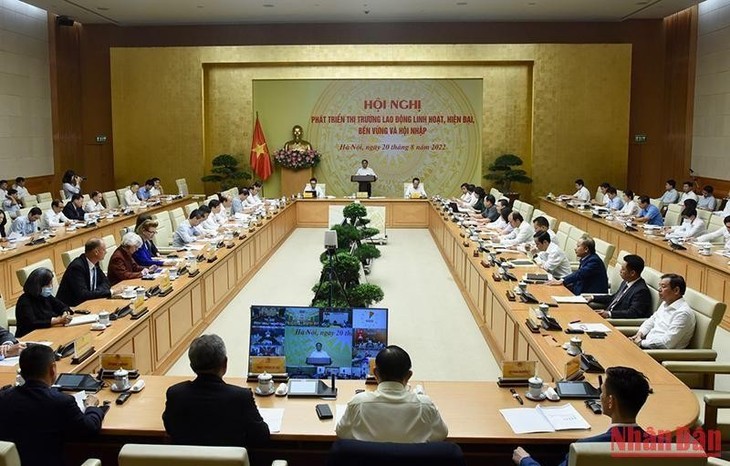(VOVWORLD) - Labor is a fundamental input factor of all production and business activities and the whole economy. At an online conference called "Develop a flexible, modern, sustainable and integrated labor market" chaired by Prime Minister Pham Minh Chinh last week, several important solutions were introduced to effectively exploit the labor market.
 Prime Minister Pham Minh Chinh chaired at online conference called "Develop a flexible, modern, sustainable and integrated labor market" Prime Minister Pham Minh Chinh chaired at online conference called "Develop a flexible, modern, sustainable and integrated labor market" |
Over the years, Vietnam’s labor market has integrated steadily and gradually approached the regional and global labor market.
Vietnam’s labor market recovers steadily
According to the Ministry of Labor, Invalids and Social Affairs, Vietnam's labor market in the first 7 months of this year was still hit by the COVID-19 pandemic. In the first quarter, nearly 17 million people aged 15 and over were affected. That figure fell to 8 million in the second quarter. The percentage of unemployed workers has also fallen.
Vietnam’s labor market is recovering quickly, with relative growth in the labor force and employment. The labor structure is moving toward a positive direction, job quality has improved, and average monthly income has increased.
In the first 6 months of 2022, the labor force had 51.4 million workers, up 400,000 from the same period last year. The labor force increased sharply in urban areas and decreased in rural areas.
The employment rate in has increased 0.6% since the 4th quarter of 2021. As soon as the epidemic was under control, workers began returning to the labor market. The average income of employees in the first 6 months of 2022 was up 5.3% from the same period last year.
New policies to create jobs and support the labor market have been implemented. Under government resolutions, Vietnam spent more than 3.5 billion USD to help 700,000 employers and nearly 50 million workers. Currently, the Prime Minister’s decision to subsidize housing for workers, with a total cost of 282 million USD is being rolled out in localities.
Labor force fully tapped to boost rapid, sustainable development
Vietnam's 10-year socio-economic development strategy to become a developing country with modern industry by 2030 and a developed country by 2045 defines human resource development as one of three strategic breakthroughs.
Vietnam will continue to perfect its institutions, policies and laws so that the labor market develops in a flexible, modern, complete, sustainable, effective manner toward international integration. Vietnam aims to liberate production capacity, focus on developing skilled labor, and create sustainable, high-income jobs. The country will continue to promote international cooperation and strengthen labor market links at home and abroad.
In the context of globalization, Vietnam will develop its labor market with a focus on digital transformation, green transformation, climate change response, and investing in mechanisms, policies, and resources to build a multi-tiered labor market information and forecasting system at all levels.
Basing employment policies on the principles of accurate forecasting, strategic vision, initiative, and conformity with the market mechanism will help create new, high-quality. sustainable, and green jobs and jobs for disadvantaged and remote areas while accelerating digital transformation and energy transition.
Vietnam has also focused on geographical movement of labor, job market links between regions, and automatic supply-demand mechanisms between domestic and foreign markets, and skill training to help workers integrate with the world labor market.